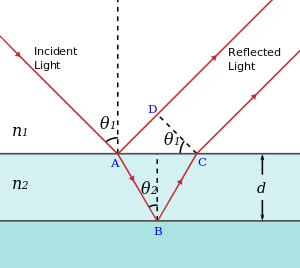In everyday life, the interference of light most commonly gives rise to easily observable effects when light impinges on a thin film of some transparent material. For instance, the brilliant colours seen in soap bubbles, in oil films floating on puddles of water, and in the feathers of a peacock’s tail, are due to interference of this type.
Interference in Thin Films:

Light wave interference results when two waves are traveling through a medium and meet up at the same location. When a wave (light waves included) reaches the boundary between two media, a portion of the wave reflects off the boundary and a portion is transmitted across the boundary. The reflected portion of the wave remains in the original medium. The transmitted portion of the wave enters the new medium and continues traveling through it until it reaches a subsequent boundary. If the new medium is a thin film, then the transmitted wave does not travel far before it reaches a new boundary and undergoes the usual reflection and transmission behavior. Thus, there are two waves that emerge from the film – one wave that is reflected off the top of the film and the other wave that reflects off the bottom of the film.
conditions for interference:
These two waves could interfere constructively if they meet two conditions.
One condition is that the two waves must be relatively close together such that their crests and troughs can meet up with each other and cause the interference. To meet this condition, the light must be incident at angles close to zero with respect to the normal.
Second condition that must be met is that the wave that travels through the film and back into the original medium must have traveled just the right distance such that it is in phase with the other reflected wave. Two waves that are in phase are waves that are always at the same point on their wave cycle. That is, the two waves must be forming crests at the same location and at the same moment in time and forming troughs at the same location and at the same moment in time. In order for the second condition to occur, the thickness of the film must be just perfect.
Mathematical Expression for Interference:


please provide as pdf
Please provide a pdf to mail id